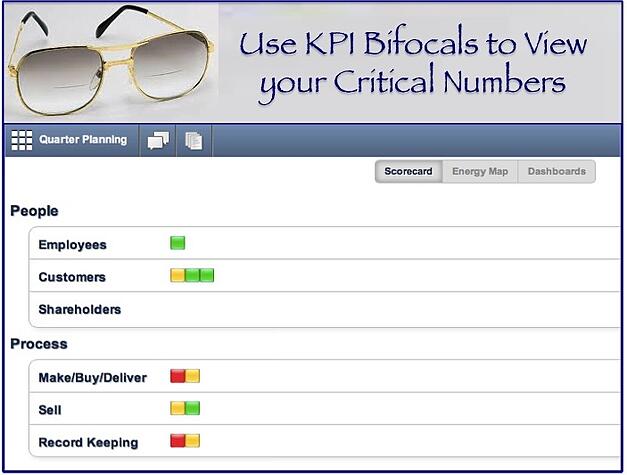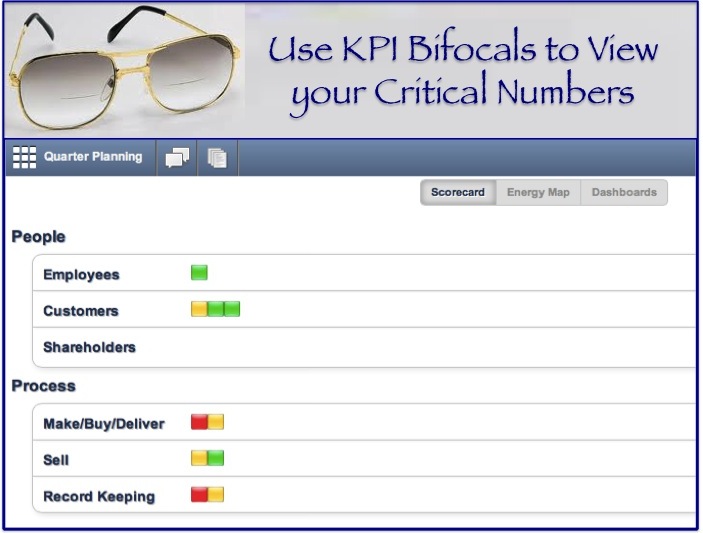I’ve had a few major incidents regarding eyes - two that I cannot forget. One was getting my first pair of glasses, and the second, a few years later, was my first pair of bifocals. Although it felt personally traumatic, it was a perfect illustration of regularly revisiting – and as appropriate, refocusing – your KPIs. In fact, it is even more important to focus on a special one or two KPIs. So, why should you care about a “special” KPI which we call your Critical Number?
KPIs are ongoing metrics that track and measure the health of your company over time as you execute toward your goals, and they can be leading or results indicators. If you recently watched my webinar with Patrick Thean, How to Use KPIs to Focus Your Team and Keep Your Plan on Track, then you already know that I prefer as many leading indicators as I can get.
In our KPI Guide, KPIs to Drive Your Business, Patrick Thean and Chris Cosper list 5 tips to help you evaluate your current KPIs. I’ll use tip #3 (Use Leading Indicators to Drive Results) to reintroduce my first question: “Why should you care about a 'special' KPI which we call your Critical Number?”
You should care because you want your team focused, accountable, and independently able to make adjustments to hit your plan. In other words, you want them to see with bifocal clarity the fine print of their daily decisions on the things that are most important to your company’s success so you can avoid business and cash flow stumbles. Why bother otherwise?
The way I coach Rhythm clients to best leverage Critical Numbers is to move from Results Indicators (lagging) to Leading Indicators. This begins with the question, “what results are we trying to achieve, what drives those results, and how do we measure it?” Results Indicators are the usual suspects of EBIDTA, revenue, NPS (Net Promoter Scores), customer satisfaction, employees/clients turnover, etc. All of these represent after-the-fact measurements. Results Indicators REPORT the outcome. They let you know where you ended up – but, they are driven by your Leading Indicators.
Leading Indicators GUIDE you. They give you a glimpse into the future and help you see where you need to make adjustments as early as possible. It takes effort and thought to develop Leading Indicators.
For example, let’s assume revenue generally takes 2.5 months to realize from the first meeting with a prospect. If revenue is measured after the sales data is entered and, according to your accounting, after the money is collected, there are many earlier indicators of revenue. Leading Indicators that would lead you to make adjustments sooner, therefore reducing any slump in revenue (by volume, length, or both). These earlier indicators might include number of sales meetings, call connect ratio, presentations requested, daily bookings, daily sales entered, average per daily sale, and on and on. The key is to move the opportunity for adjustment as far in advance of when the revenue is realized so that you make more meaningful adjustments sooner.
Great, you might say, but what is a Critical Number and how does it relate to Leading Indicators to drive results? Critical numbers are metrics designed to drive a company priority that will be highlighted for a specific period of time (often a quarter or annual period). The purpose is to make a specific improvement in your company.
Use our KPI creator tool to begin determining your KPIs. These should be put in some type of dashboard for weekly discussion. Ours looks like this:

If you aren’t using Rhythm, use a spreadsheet, graph, or even a large whiteboard.
Once KPIs are chosen, the secret to accountability and keeping your team on track toward achieving the plan is Red-Yellow-Green criteria for every KPI. To keep us on point, let me just say that your criteria should be specific and measurable.
Why Care about a Special KPI or Critical Number?
If you already have a theme for the quarter or the year, consider what lever allows you to drive/push that focus. The “special” KPI idea came from Jack Stack, author The Great Game of Business. This is one KPI that is considered more important than all the others: one that will receive the most attention and effort during this specific period of time to move it to green or super green. Jack Stack drove Critical Numbers to achieve a result. He used this focus in beginning his company, SRC. He communicated that if the team didn’t reduce debt to equity then the company would die (ratio at time was 89:1). He afterward realized that it gave the company intense focus, and the company grew from one company to over 30 entities and somewhere in the neighborhood of $450M in revenue!
At Rhythm Systems, we use Critical Numbers in a similar way with the slight difference that we suggest two Critical Numbers, not one. One Critical Number drives your short-term goal, and a second one is the counterbalance. Our experience working with fast growth companies is that when you focus on and optimize one area of the company, in so doing, you often create another challenge unintentionally.
Here are three examples of focus on a single number rather than two and possible unintentional negative consequences:
1. You decide that your Critical Number is related to customer service and loyalty. You spend one year measuring and focusing on improving NPS (Net Promoter Score) and see great results. At the end of the year you realize that although customer satisfaction grew like a tidal wave, your sales dropped as if you’d been torpedoed! It’s possible your next move might be number two below.
2. You determine that sales is critical and set your Critical Number in relation to revenue. Your sales and support team stay focused and deliver a revenue increase of 29%. Meanwhile, you lose key accounts due to an inability to deliver the promised service/product. Or, your CFO delivers the news that margins dropped 19% since the sales team was greatly discounting to drive revenue.
3. Your freight costs (and fuel add-on charges) were going though the roof so you and your team brainstormed weekly to drive these costs down. As costs dropped, you felt successful, but it wasn’t long before your customer complaints skyrocketed as a result. Examples included boxes that fall apart in shipping, broken parts or products due to lack of proper packing material, etc.
The reason we care about KPIs and the “special” KPIs, Critical Numbers, is to drive decisions (and direction) in your company. Here is the practical application: determine your number one Critical Number to drive your short-term goal, and then ask, “If we focus on this critical number, what might we accidentally overlook or neglect? What unintended negative consequence might occur?” Your answer to this question will help you determine your number two Critical Number. You will want this second Critical Number to counterbalance against overextending toward your number one – a bifocal approach!
As your company matures into a consistent Gazelle-like performer, you’ll need to put on your business plan bifocals to improve the sight, ‘er vision, of your team. Using KPI bifocals to see your critical numbers is part of that better vision.
Photo Credit: iStock by Getty Images



 LinkedIn
LinkedIn
 Facebook
Facebook
